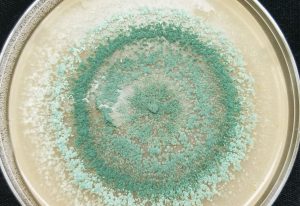
Fungi
Diversity and importance for the ecosystems and soil quality
Perhaps the first image that comes to a person’s mind when thinking about fungi is that of a common white button mushroom, or the famous fly agaric (Amanita muscaria), which is the red with white scales, or perhaps the annoying fungus that causes athlete’s foot.
However mushrooms are much more than that. These organisms, which are neither plants nor animals, are part of their own
kingdom, named Fungi, and are even known to be more evolutionarily related to animals. According to recent studies, it is estimated that there may be more than 3 million species, of which approximately 120,000 are known (Hawksworth and Lücking 2017). All this diversity includes not only the species that are mentioned at the beginning, but also a great variety of mushrooms, microscopic fungi such as molds, yeasts, aquatic fungi, parasites of animals, plants, and even other fungi.

Mycelium in soil
Photography: Alison Harrington (CC BY- SA2.0)
Of all these species, only approximately 10% form structures visible to the naked eye like mushrooms (Mueller et al. 2007), which are only the structures in which spores are produced, something analogous to fruits in plants. Both macroscopic and microscopic fungi form a network of filamentous cells, called hyphae, which together form the mycelium. The latter is either microscopic or can be seen as a cottony growth in leaf litter, on rotting logs, or simply as mold on bread and other food.
Fungi are of vital importance in terrestrial ecosystems, particularly in the formation and fertility of the soil, since they accomplish the role of decomposers, that is, they degrade the organic matter that comes from plants, animals and other organisms and make nutrients available for plants to be able to absorb them. In fact, some components of the wood can only be decomposed by fungi, which, if they did not exist, would accumulate in forests and jungles. Parasites also play an important role, by regulating the populations of other organisms such as old trees, insects, and can even affect agricultural production of fruits and vegetables, as well as forestry.
“Fungi are of vital importance in terrestrial ecosystems, particularly in the formation and fertility of the soil, since they accomplish the role of decomposers.”
Another group of fungi is closely associated with the roots of plants forming the so-called “mycorrhiza”. Some of these fungi are mushroom-forming (ectomycorrhizal) whose hyphae surround tree roots and spread into areas of the soil where the roots cannot reach, significantly increasing the volume of soil in which the fungi can extract water and minerals, which are also used by associated plants. In return, the fungi take advantage of the food that the plants produce through photosynthesis, forming a win-win relationship, called mutualism. Other species of fungi, more abundant in the tropics, are endomycorrhizal, which fulfill a function similar to those described above but do not form mushrooms (they are entirely microscopic) and penetrate the cell wall of root cells.

Cantharellus coccolobae, un hongo ectomicorrícico tropical Cantharellus coccolobae, a tropical ectomycorrhizal fungus
Photography: Juan P. Pinzón
About 90% of plants are known to associate with endomycorrhizal fungi (Begum et al. 2019), which gives us an idea of their rele-
vance. It should be noted that the spores of these fungi are sold as biofertilizers and are an excellent environmentally friendly option, since they are not as polluting as chemical fertilizers can be. Some other fungi, in particular species of the genus Trichoderma, have been used for biocontrol, since they are efficient in protecting the plants they colonize against other pathogenic fungi (Zin and Badaluddin 2020). On the other hand, it has been observed that some species of fungi can help decontaminate soils by capturing heavy metals such as cadmium, copper, mercury, lead, etc. (Frąc et al. 2018) or enzymes
can be extracted to decontaminate wastewater from textile, paper, and petrochemical industries, among many other applications (Strong and Claus 2011).

Esporas e hifas de Glomus sp., un hongo micorrícico arbuscular (endomicorrícico)
Photography: José Ramos Zapata.
“It has been observed that some species of fungi can help decontaminate soils by capturing heavy metals.”
As it has been exposed above, in addition to their better-known relevance as edible and medicinal beings, fungi are extremely important for the health of the ecosystem, particularly for the development of good quality soil, both in natural environments and in productive areas. The study of fungi, their application and management, is relevant today more than ever.

Trichoderma sp. culture plate
Photography: Scot Nelson
REFERENCIAS BIBLIOGRÁFICAS / REFERENCES:
Begum, Naheeda, Cheng Qin, Muhammad Abass Ahanger, Sajjad Raza, Muhammad Ishfaq Khan, Muhammad Ashraf, Nadeem Ahmed y Linxin Zhang. 2019. “Role of arbuscular mycorrhizal fungi in plant growth regulation: implications in abiotic stress tolerance.” Frontiers in Plant Science 10: 1068. https://doi.org/10.3389/fpls.2019.01068.
Frąc, Magdalena, Silja E. Hannula, Marta Bełka y Małgorzata Jedryczka. 2018. “Fungal biodiversity and their role in Soil Health.” Frontiers in Microbiology 9: 707. https://doi. org/10.3389/fmicb.2018.00707.
Hawksworth, David L. y Robert Lücking. 2017. “Fungal diversity revisited: 2.2 to 3.8 million species.” Microbiology Spectrum 5 (4): 1-17. https://doi.org/10.1128/microbiolspec. FUNK-0052-2016.
Mueller, Gregory M., John P. Schmit, Patrick R. Leacock, Bart Buyck, Joaquín Cifuentes, Dennis E. Desjardin, Roy E. Halling, Kurt Hjortstam, Teresa Iturriaga, Karl-Henrik
Larsson, D. Jean Lodge Tom W. May, David Minter, Mario Rajchenberg, Scott A. Redhead, Leif Ryvarden, James M. Trappe, Roy Watling y Qiuxin Wu. 2007. “Global diversity and distribution of macrofungi.” Biodiversity Conservation 16: 37-48.https://doi.org/10.1007/s10531-006-9108-8. Strong, P. J. y H. Claus. 2011. “Laccase: A review of its past and its future in bioremediation.” Critical Reviews in Environmental Science and Technology 41 (4): 373-434. http:// dx.doi.org/10.1080/10643380902945706.
Zin, Nur A. y Noor A. Badaluddin. 2020. “Biological functions of Trichoderma spp. for agriculture applications.” Annals of Agricultural Sciences 65: 168-178. https://doi.
org/10.1016/j.aoas.2020.09.003.











